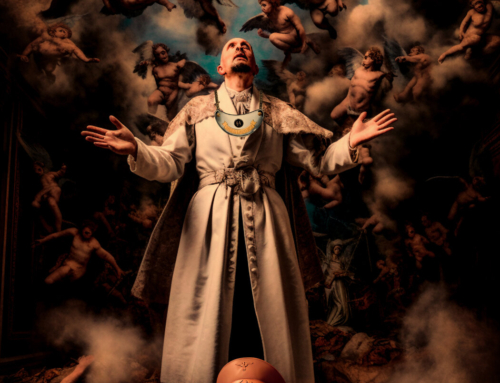On social media this week some of our Protestant brothers have been using this story of St Dismas–the repentant thief who was crucified with Jesus–to take some pokes at the Catholic Church teaching.
“You Catholics say baptism and Eucharist and good works are necessary for salvation, but what about the Good Thief huh? All he had was his faith in Jesus and Jesus said, “Today you will be with me in paradise.” The Good thief wasn’t baptized. He never received communion. He wasn’t able to do any good works, so he is an example of sola fide–salvation by faith alone! See! Gotcha!”
Take a deep breath. Here’s some background on the Good Thief. He is traditionally named St Dismas after being named as such in the 4th c. apocryphal Gospel of Nicodemus. Note that his name Dismas is but one of other varied traditions. The Coptic tradition names him Demas. The Arabic Infancy Narrative calls him Titus and the Russian tradition names him Rakh. So, since we are Western Christians let us follow our tradition and call him Dismas.
Scholars believe Dismas may have been an ordinary brigand who operated as a bandit–robbing travelers and pilgrims. Others, inferring from the activities of Barrabas, conclude that he and the other thief were not just bandits, but a terrorists– guerrilla fighters against the Roman occupation. The fact that Dismas is interested in whether Jesus is the Messiah leads me to lean to the second opinion–he was (or sympathetic to) the Zealots–the Jewish subset who advocated political overthrow of Rome and the establishment of a Messianic Jewish kingdom.
The Gospel of Luke is the only gospel that records his penitence and faith in the Lord. So what shall we make of the claims that he was saved without baptism and Eucharist and without good works?
First of all, let us set aside the idea that the Catholic Church teaches that good works are necessary for salvation. This is not Catholic teaching. The Catholic Church teaches that we are saved by Grace alone through faith and that faith is proved by good works. We accomplish good works only through God’s empowering grace, and these good works are the way we co-operate with God’s grace. The works are not distinct from our faith, therefore, but are one with our faith. As the Sacred Scriptures teach, “Faith without works is dead” (James 2:14-26)
So what about baptism and Eucharist? Certainly the Good Thief was not able to be baptized after his public profession of faith in the Lord Jesus on the cross, but we do not know if he was baptized or not at some earlier point. Baptism was part of the Jewish ceremonial and ritual life–thus John the Baptist’s activities at the Jordan.
Although the term “baptism” is not used to describe the Jewish rituals, the purification rites in Halakha, Jewish law and tradition, called tvilah, have some similarity to baptism, and the two have been linked. The tvilah is the act of immersion in naturally sourced water, called a mikva.
So, if Dismas was a practicing Jew he would have participated in Halakha, and if he was a Zealot may very well have been one of the many people baptized by John the Baptist himself. So, while we cannot say for certain that he was baptized, we also cannot say for certain that he was not. Furthermore, the Protestant objection is rooted in an assumption of “believer’s baptism”–that baptism must follow the profession of individual faith. However, this is not, and never has been, the predominant Christian understanding–indeed just the reverse–that baptism will usually precede (and enable) the personal profession of faith. Therefore proposing that Dismas may have been baptized (albeit a pre-Christian Jewish similitude of baptism) is not unreasonable to suppose.
In any case, Catholic theology (unlike Calvinism for example) is flexible where it needs to be in order to account for the providence of God and the unpredictability of his mercy. We teach that there is something called “baptism of blood” and “baptism of desire”. Baptism of blood is the application of the grace of baptism by virtue of the shedding of the unbaptized person’s blood in martyrdom. An example of this recently was the unbaptized man who joined himself with the twenty one Coptic Christians who were beheaded in 2015 on a beach in Libya. Baptism of desire applies to unbaptized people who die without the sacrament but who are people of faith in Christ but who, for whatever reason, were not able to be baptized. “Baptism of desire” is so called because they would have received baptism if they knew of it and were able to be baptized.
But let us think outside the box for a moment. While both baptism of blood and baptism of desire would apply to Dismas, there may be more to the story.
It is part of the tradition that Dismas was crucified on the right hand side of Our Lord and the impenitent thief on his left. This detail echoes nicely with Jesus’ parable of the judgment in Matthew 25:34 when the King says to “those on his right ‘Come, you who are blessed of My Father, inherit the kingdom prepared for you from the foundation of the world”
But there is more to it than this link. Which side of Jesus was pierced by the spear of Longinus? The gospels do not say, but the tradition is that it was the right side–and this tradition was probably established upon meditation on Matthew 25:34–the right side being the side of salvation. If this is so, and Dismas was on the right hand side he would have been sprinkled with the blood and water that spurted from Christ’s side.
The church has, from the beginning, viewed the blood and water from Christ’s side as being the source and foundation of the two sacraments of baptism and Eucharist. Therefore, since Dismas was sprinkled with the blood of the lamb, (and maybe some touched his lips) we would say he partook (literally) of the blood of Christ. If the water from our Lord’s side also sprinkled on him he received the sacrament of baptism in a way that should satisfy the most literally minded of our Protestant brothers.
Furthermore, the experience of St Dismas–as brutal and visceral as it was–reminds us that our own baptism and reception of the Eucharist is a real and true participation in the passion, death, resurrection and ascension of Our Lord Jesus Christ. We were not “crucified with Christ” to the same terrible degree of St Dismas, but his participation in Our Lord’s passion is a revelation and witness to our own.
Any other questions?







I was asked before about the role of works and the Good Thief was brought up. Simply said faith and works are two sides to one coin, two cords of one rope – inseparable as heat and light, pleasure and pain.
That said, good works don’t just include external acts of charity, but also an act of the will. So St Dismas calling out to Christ to redeem him was itself an action springing from inner faith after Christ reveals who He truly is, and what His mission is – rebuilding the burnt bridges between Man and God.